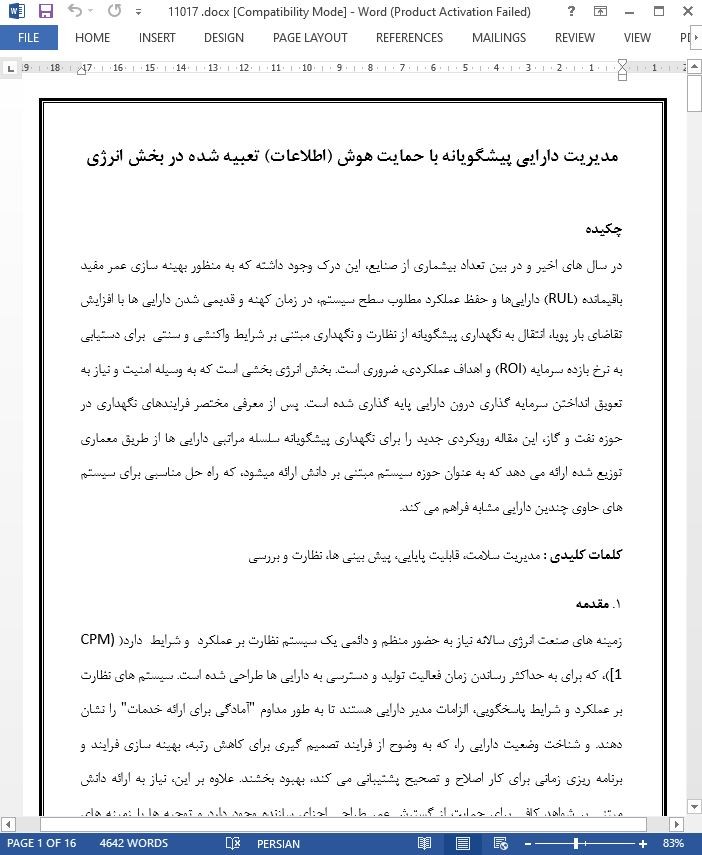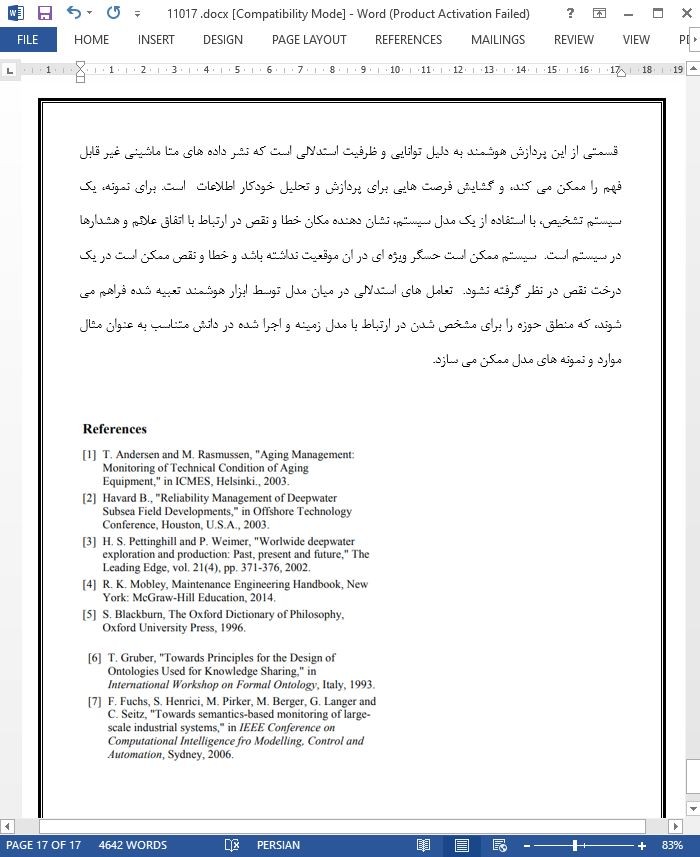
مدیریت دارایی پیشگویانه با حمایت هوش (اطلاعات) تعبیه شده در بخش انرژی
چکیده
در سال های اخیر و در بین تعداد بیشماری از صنایع، این درک وجود داشته که به منظور بهینه سازی عمر مفید باقیمانده (RUL) دارایی¬ها و حفظ عملکرد مطلوب سطح سیستم، در زمان کهنه و قدیمی شدن دارایی ها با افزایش تقاضای بار پویا، انتقال به نگهداری پیشگویانه از نظارت و نگهداری مبتنی بر شرایط واکنشی و سنتی برای دستیابی به نرخ بازده سرمایه (ROI) و اهداف عملکردی، ضروری است. بخش انرژی بخشي است كه به وسيله امنيت و نياز به تعویق انداختن سرمايه گذاري درون دارايي پايه گذاري شده است. پس از معرفی مختصر فرایندهای نگهداری در حوزه نفت و گاز، این مقاله رویکردی جدید را برای نگهداری پیشگویانه سلسله مراتبی دارایی ها از طریق معماری توزیع شده ارائه می دهد که به عنوان حوزه سیستم مبتنی بر دانش ارائه میشود، که راه حل مناسبی برای سیستم های حاوی چندین دارایی مشابه فراهم می کند.
1. مقدمه
زمینه های صنعت انرژی سالانه نیاز به حضور منظم و دائمی یک سیستم نظارت بر عملکرد و شرایط دارد(CPM) [1)، که برای به حداکثر رساندن زمان فعالیت تولید و دسترسی به دارایی ها طراحی شده است. سیستم های نظارت بر عملکرد و شرایط پاسخگویی، الزامات مدیر دارایی هستند تا به طور مداوم "آمادگی برای ارائه خدمات" را نشان دهند. و شناخت وضعیت دارایی را، که به وضوح از فرایند تصمیم گیری برای کاهش رتبه، بهینه سازی فرایند و برنامه ریزی زمانی برای کار اصلاح و تصحیح پشتیبانی می کند، بهبود بخشند. علاوه بر این، نیاز به ارائه دانش مبتنی بر شواهد کافی برای حمایت از گسترش عمر طراحی اجزای سازنده وجود دارد و توجیه ها با زمینه های ساخت و ساز گره می خورد.
4- نتایج
رویکرد جدیدی برای تعمیر و نگهداری سلسله مراتبی پیش گویانه دارایی ها در حوزه نفت و گاز خلاصه شده است. از طریق معماری توزیع داده شده، که به عنوان حوزه سیستم مبتنی بر دانش نشان داده شده، این رویکرد یک راه حل قابل اعتمادی برای سیستم های شامل دارایی های چندگانه مشابه فراهم می کند. مدل حوزه نشان دهنده مدل هایی از بسیاری ار جنبه های سیستم ( از جمله یک تغییر شکل فیزیکی در میان تغییر شکل های دیگر ) و نقشه هایی برای شاخص های کلیدی عملکرد است.این رویکرد، تشخیص خطا و نقص را از ابزار تعبیه شده هوشمند انجام شده در سطوح متفاوت در میان سیستم توزیع شده نفت و گاز و مناسب ترین انتخاب های مدل سازی مورد استفاده برای مشکلات خاص و ویژه را ممکن می کند.
Abstract
In recent years and across a myriad of industries, there has been a realisation that in order to optimise the Remaining Useful Life (RUL) of assets and to maintain optimal system level performance whilst assets age and at times with growing and dynamic loading demands, a transition to predictive maintenance from reactive and traditional condition based monitoring and maintenance is required to achieve return of investment (ROI) and performance targets. A sector driven by security and a need to defer investment within the asset base is the Energy sector. After a brief introduction to maintenance process's in the oil and gas domain, this paper presents a novel approach to hierarchical predictive maintenance of assets in through a distributed architecture, represented as domain knowledge-based system, that provides a viable solution for systems containing similar multiple assets.
1 Introduction
Year-round energy industry fields require the routine and permanent presence of a condition and performance monitoring (CPM) system [1], designed to maximise production uptime and asset availability. CPM systems respond to the asset manager’s need to continuously demonstrate ‘fitness for service’; and improve understanding of asset condition, which obviously support the decision making process for de-rating, process optimisation and scheduling for remediation and rectification task. Furthermore, there is also a requirement to provide enough evidence based knowledge to support the extension of the design life of components, and justifications tie with brown fields.
4 Conclusions
A novel approach to hierarchical predictive maintenance of assets in the oil and gas domain has been outlined. Through a distributed architecture, represented as domain knowledgebased system, it provides a viable solution for systems containing similar multiple assets. The domain model represents models of many aspects of the system (including a physical decomposition among others) and maps to Key Performance Indicators (KPI’s). The approach allows fault diagnosis from intelligent embedded tools to be performed at different levels within the oil and gas distributed system and the most appropriate modeling choices to be used for particular problems.
چکیده
1. مقدمه
2 فرآیندهای نگهداری و تعمیر در صنعت نفت و گاز
3 جریان داده در فرآیندهای تعمیر و نگهداری
-4 سیستم مبتنی بر دانش برای حوزه تعمیر و نگهداری
4.1 مدل نگهداری پیشگویانه
5- معماری سیستم
4- نتایج
Abstract
1 Introduction
2 Maintenance processes in the oil and gas industry
3 Data flow in maintenance processes
4 Knowledge-based system for maintenance domain
4.1 Model for predictive maintenance
5 System Architecture
4 Conclusions
- اصل مقاله انگلیسی با فرمت ورد (word) با قابلیت ویرایش
- ترجمه فارسی مقاله با فرمت ورد (word) با قابلیت ویرایش، بدون آرم سایت ای ترجمه
- ترجمه فارسی مقاله با فرمت pdf، بدون آرم سایت ای ترجمه



